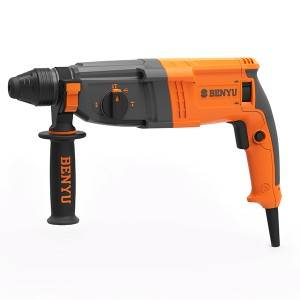Working principle of brushed electric drill
The Hammer Drill 28MM main structure of the brushed electric drill is the stator + rotor + brushes, which obtain the rotational torque through the rotating magnetic field, thereby outputting kinetic energy. The brush and the commutator are in constant contact and friction, and play a role of conduction and commutation during rotation.
The brushed electric drill adopts mechanical commutation, the magnetic pole does not move, and the coil rotates. When the electric drill is working, the coil and the commutator rotate, but the magnetic steel and carbon brush do not rotate. The alternating current direction of the coil is changed by the inverter and the electric brush that rotate with the electric drill.

In this process, the two power input ends of the coil are arranged in a ring in turn, separated from each other by insulating materials to form a cylinder, which is connected to the electric drill shaft. The power supply is made of two carbon elements. Small pillars (carbon brushes), under the action of spring pressure, press two points on the upper coil power input ring cylinder from two specific fixed positions to energize the coil.
As the electric drill rotates, different coils or the two poles of the same coil are energized at different times, so that the NS pole of the coil generating the magnetic field and the NS pole of the closest permanent magnet stator have a suitable angle difference. , Generate power to push the electric drill to rotate. The carbon electrode slides on the coil terminal, like a brush on the surface of the object, so it is called a carbon “brush”.
The so-called “successful brushes, failure also brushes.” Due to the mutual sliding, the carbon brushes will be rubbed, causing loss. The on and off of the carbon brushes and the coil terminals will alternate, and electric sparks will occur, electromagnetic breakage will be generated, and electronic equipment will be disturbed. Furthermore, due to continuous sliding and friction, the brushes will be Constant wear and tear is also the culprit for the short-lived brush drill.
If the brush is damaged, it needs to be repaired, but will it be troublesome to repair it again and again? In fact, it won’t, but wouldn’t it be better if there is an electric drill that does not need to change the brush? This is the brushless drill.
Working principle of brushless electric drill
Brushless electric drill, as the name suggests, is an electric drill without electric brush. Now that there is no electric brush, how can the electric drill continue to run?
It turns out that the structure of a brushless electric drill is exactly the opposite of that of a brushed electric drill:
In the brushless electric drill, the work of commutation is completed by the control circuit in the controller (usually Hall sensor + controller, more advanced technology is magnetic encoder).
The brushed electric drill has a fixed magnetic pole and the coil turns; a brushless electric drill has a fixed coil and the magnetic pole turns. In the brushless electric drill, the Hall sensor is used to sense the position of the magnetic pole of the permanent magnet, and then according to this perception, the electronic circuit is used to switch the direction of the current in the coil at the right time to ensure that the magnetic force in the correct direction is generated to drive the electric drill. Eliminate the shortcomings of brushed electric drills.
These circuits are the controllers of brushless electric drills. They can also implement some functions that cannot be realized by brushed electric drills, such as adjusting the power switch angle, braking the electric drill, making the electric drill reverse, locking the electric drill, and using the brake signal to stop powering the electric drill. . The electronic alarm lock of the battery car now makes full use of these functions.
Post time: Sep-24-2022
